If you have just had ceramic coating applied to your car, congratulations! That invisible paint protection film will help keep your vehicle looking flawless for years to come, but only if you take care of it properly. So, how do you detail a car with ceramic coating?

Here are a few essential tips on how to detail a car that has ceramic coating:
- Do not wash your car within 7 days of application.
- Avoid automated car washes.
- Use a soft microfiber wash mitt.
- Choose the right car shampoo.
- Do not use harsh chemicals or abrasives on your paint.
- Always wash your car in the shade.
- Use the two-bucket wash method.
- Rinse thoroughly and dry completely.
- Always use clean towels and microfiber cloth.
- Wax or seal your car after every wash.
- Touch up any chips or scratches immediately.
The rest of this article will describe each of these tips in detail so that you can keep your ceramic coating looking its best. Read on for crucial information on how to take care of your new paint protection film!
1. Do Not Wash Your Car Within 7 Days of Application
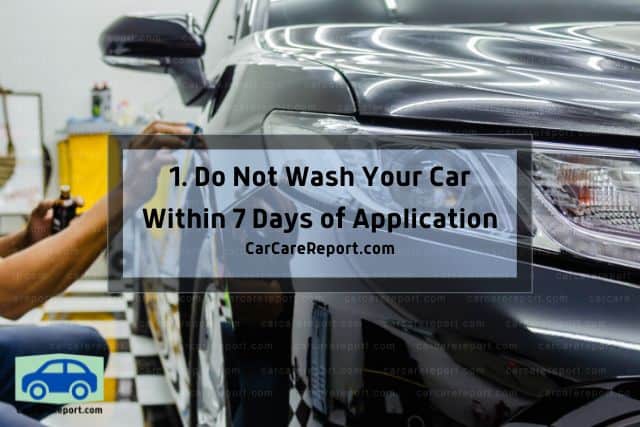
The first rule of thumb when detailing a car with ceramic coating is to wait at least seven days before washing it. The waiting period allows the ceramic coating to fully cure and bond with the paint, making it much more resistant to scratches and wash-induced swirl marks.
Besides, you want to give that brand-new coating a chance to show off its water repellency! For the first few days after application, simply avoid driving in dirty or dusty conditions.
In addition, be sure to avoid automated car washes during the curing period. The high-pressure water and harsh chemicals can strip away the ceramic coating before it has a chance to properly bond.
2. Avoid Automated Car Washes

As I mentioned, while you might be tempted to take your newly coated car through the local drive-thru car wash, resist that urge! The harsh chemicals and brushes used in automated car washes can damage the ceramic coating, making it less effective at protecting your paint.
Besides, since most drive-thru car washes have attendants who hand-wipe the car after it comes out of the wash, the chances are that they may use dirty rags or towels that could end up scratching your paint and weakening the ceramic coating. That’s especially possible during busy times when the attendants may be rushed and not take the time to clean and dry your car correctly.
3. Use a Soft Microfiber Wash Mitt

Once the seven-day curing period is up, you can finally give your car a good wash! When washing a car with ceramic coating, be sure to use a soft microfiber wash mitt.
A wash mitt made of microfiber is much less likely to cause swirl marks than one made of sponge or cloth, and it will be more gentle on the ceramic coating. In addition, make sure to use plenty of suds and rinse the mitt often to avoid scrubbing dirt and debris into the paint.
Here are a few critical guidelines for choosing the suitable microfiber wash mitt for your car:
- Look for a wash mitt made of 100% microfiber.
- Avoid wash mitts with long, shaggy fibers, which can increase the chances of scratching your paint.
- Choose a size that comfortably fits your hand to avoid fatigue while washing.
- Make sure the wash mitt is color-coded so that you can use it on different areas of your car without the risk of cross-contamination.
- Pick a wash mitt with a soft, plush pile to minimize the risk of scratching your paint.
If you need a high-quality wash mitt, go with this Amazon Basics Deluxe Microfiber Car Wash Mitt from Amazon.com. It’s made of soft, lint-free microfiber and it’s large enough to cover your entire hand, making it ideal for washing even the most delicate painted surfaces.
4. Choose the Right Car Shampoo
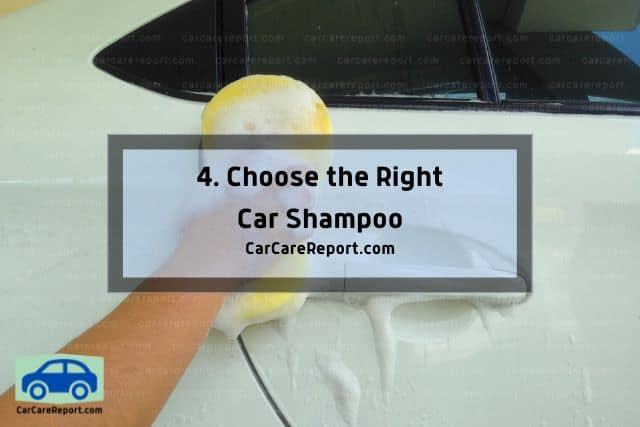
When choosing the right car shampoo for a ceramic coated car, you’ll want to look for one that is pH-neutral and doesn’t contain any harsh chemicals or abrasives.
A pH-neutral car shampoo will not strip away the ceramic coating as some harsher shampoos can. In addition, avoid car shampoos that contain abrasives such as polyethylene beads or sodium bicarbonate, as these can damage the coating.
Finally, rinse the car thoroughly after shampooing to remove any residue that could cause streaking or water spots.
5. Do Not Use Harsh Chemicals or Abrasives on Your Paint
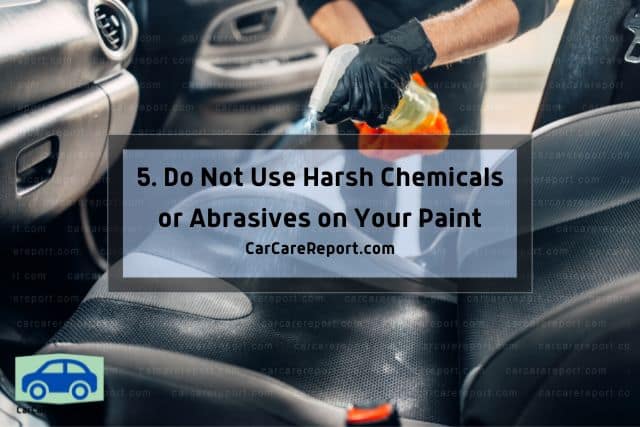
In addition to using the wrong type of car shampoo, another mistake you can make when detailing a car with ceramic coating is using harsh chemicals or abrasives on the paint.
Harsh chemicals such as gasoline, brake cleaner, or oven cleaner can strip away the ceramic coating and damage the paint. Abrasive materials such as sandpaper, steel wool, or scrubbing pads can also scratch the paint and damage the coating.
If you need to remove a stubborn stain or spot, use a product specifically designed for use on ceramic coated cars. These include clay bars, polishes, and sealants safe to use on ceramic coated vehicles.
6. Always Wash Your Car in the Shade
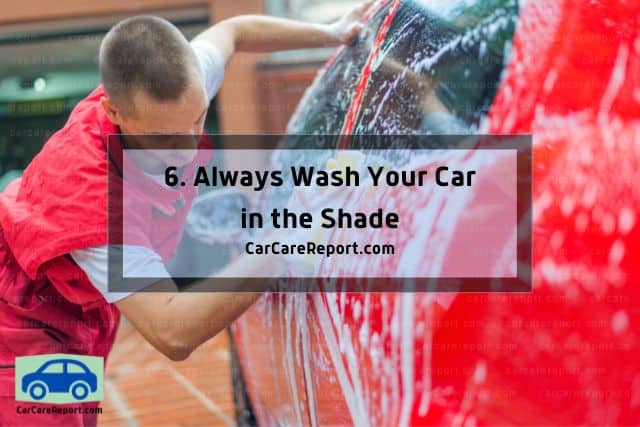
Anyone who has ever washed a car knows that one of the most important things to avoid is water spots. These spots are caused by minerals in the water that can etch into the paint, causing permanent damage.
While it may be tempting to wash your car in the sun to speed up the drying process, it will only increase the risk of water spots. Instead, wash your car in a shaded area out of direct sunlight. That will give the water a chance to evaporate before it has a chance to cause any damage.
So next time you need to wash your ceramic-coated car, find a shaded area to avoid water spots.
Pro Tip: Besides avoiding direct sunlight, here are a few practical ways to prevent water spots:
- Use distilled water instead of tap water: Distilled water is free of minerals that can cause water spots.
- Dry your car immediately after washing: The sooner you can dry your vehicle, the less likely it is that water spots will form.
- Use a waterless car wash: It uses very little water and doesn’t require drying, so it’s an effective way to avoid water spots.
- Avoid parking near water sources: If you can, avoid parking near sprinklers, puddles, or other water sources. The water may splash onto your car and cause spots.
7. Use the Two-Bucket Wash Method
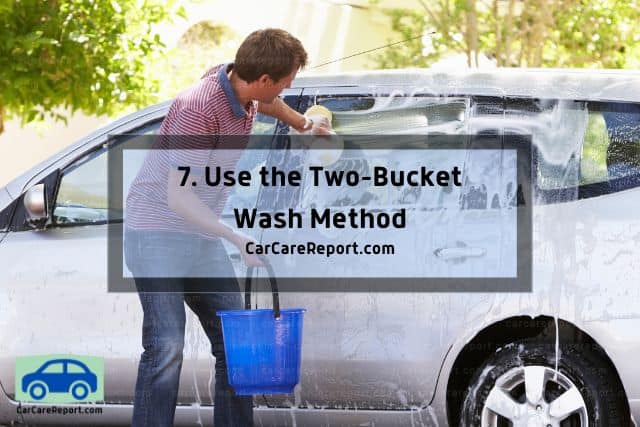
When washing your ceramic-coated car, it’s essential to use the two-bucket wash method. That means using one bucket of water for washing and one bucket of clean water for rinsing. Using separate buckets helps prevent contamination that can lead to scratches or swirl marks.
Pro Tip: It’s also essential to use a grit guard in each bucket. A grit guard is a plastic grid that sits at the bottom of the bucket and catches any dirt or debris that gets stirred up. That way, the dirt and debris don’t end up back on your wash mitt and cause scratches.
8. Rinse Thoroughly and Dry Completely
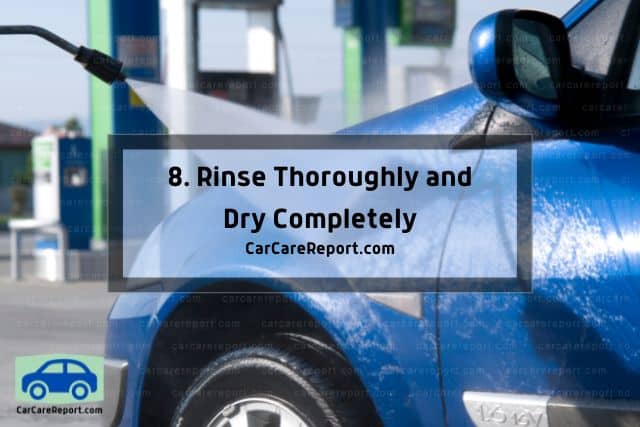
After you have given your car a good wash, the next step is to rinse it off thoroughly with clean water. Any soap residue left on the paint can cause spots or streaks. To avoid this, be sure to rinse the car thoroughly.
Once you have rinsed your car off, the next step is to dry it with a clean microfiber towel. Avoid using a harsh scrubbing motion as this can damage the coating on your car. Drying your vehicle completely will help to prevent any water spots from forming and ruining that just-washed look.
Following these simple steps will help you maintain a clean and streak-free car. Not to mention, it will also prolong the life of your paint job. So next time you go to wash your car, remember to rinse thoroughly and dry completely.
9. Always Use Clean Towels and Microfiber Cloths
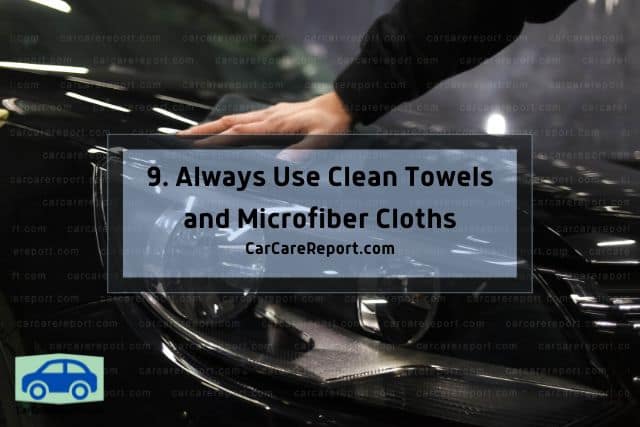
It’s essential to use clean towels and microfiber cloths when detailing a car with ceramic coating. That’s because dirty towels can harbor grit and debris that can scratch the paint.
If you’re using a towel or cloth that’s already been used, be sure to wash it in a detergent that’s designed for microfiber cloths. That will help remove any dirt or debris that could scratch the paint.
Once you’ve washed the towels or clothes, let them air dry completely before using them on your car.
10. Wax or Seal Your Car After Every Wash

Another essential step in detailing a car with ceramic coating is waxing or sealing the paint after every wash. That will help protect the coating and keep the paint looking shiny and new.
Here are some critical guidelines for waxing or sealing a ceramic coated car:
- Choose a product designed for use on ceramic coated cars: Some waxes and sealants contain harsh chemicals or abrasives that can damage the coating. The best waxes for ceramic coated vehicles are typically made with natural ingredients safe for use on the coating, such as carnauba wax.
- Apply the wax or sealant according to the manufacturer’s instructions: Read and follow the manufacturer’s instructions carefully to avoid damaging the coating.
- Apply the wax or sealant in a cool, shaded area: Hot temperatures can cause the wax or sealant to dry too quickly and be difficult to remove. Instead, apply it in a cool, shaded area out of direct sunlight.
- Buff the wax or sealant off with a soft cloth: Use a clean, soft cloth to buff the wax or sealant off the paint. Avoid using a harsh scrubbing motion, as that can damage the coating.
Pro Tip: If you don’t have time to wax or seal your car after every wash, you can extend the life of the coating by using a quick detailer spray in between washes. Quick detailer sprays can help remove dust and fingerprints while providing a layer of protection against the elements.
11. Touch Up Any Chips or Scratches Immediately

One of the benefits of ceramic coating is that it can help prevent minor scratches and chips in the paint. However, if you do happen to scratch or chip your paint, it’s essential to touch up the area as soon as possible.
First published on Sep 21, 2022 by CarCareReport.com.
If the scratch or chip is small, you can touch it up with a paint pen or brush. Be sure to match the paint color to make the repair less noticeable.
For larger scratches or chips, you’ll need to use a touch-up kit. These kits typically have everything you need to repair the damage, including:
- Paint: The paint in the kit should be an exact match to your car’s paint color.
- Filler: The filler is used to fill in any deep scratches or chips.
- Clear Coat: The clear coat helps protect the repair and blend it in with the surrounding paint.
- Sandpaper: You’ll need to sand the area before applying the filler and paint.
Once you’ve bought the mentioned items, follow these steps to touch up the damage:
- Clean the area around the scratch or chip: Use a clean cloth and some isopropyl alcohol to remove any dirt or debris from the area.
- Sand the area around the scratch or chip: Use fine-grit sandpaper to sand down the area around the scratch or chip. This will help the filler and paint adhere to the surface.
- Wipe away any dust: Use a clean cloth to remove any dust from the sanding process.
- Apply the filler: Use the filler included in the kit to fill in any deep scratches or chips.
- Apply the paint: Use the paint included in the kit to cover the filler and match the surrounding paint color.
- Apply the clear coat: Use the clear coat included in the kit to protect the repair and help it blend in with the surrounding paint.
- Let everything dry: Once you’ve applied the filler, paint, and clear coat, let them dry completely before using the car.
Note: If you’re pressed for time or don’t feel confident in your ability to touch up the damage, you can always take your car to a professional detailer. They’ll be able to repair the damage quickly and efficiently. Just ensure that they use high-quality paint that matches your car’s color.
Wrap Up
Ceramic coating is a clear, thin layer of protection that bonds to your car’s paint and helps protect it from the elements. However, it’s important to note that ceramic coating is not a replacement for regular washing and maintenance.
To detail a car with ceramic coating ensure you follow the tips I’ve mentioned above. These tips will help you keep your car’s paint in pristine condition and make the most of your ceramic coating.
Related Articles
How To Clean a Car Interior With Household Products
How To Hand Wash a Car Faster (Tips and Tricks)
Shampoo vs. Steam Clean: Which is Better for a Car?
How To Use a Rubbing Compound on Clear Coat
CarCareReport dot com first published this article on Sep 21, 2022..
